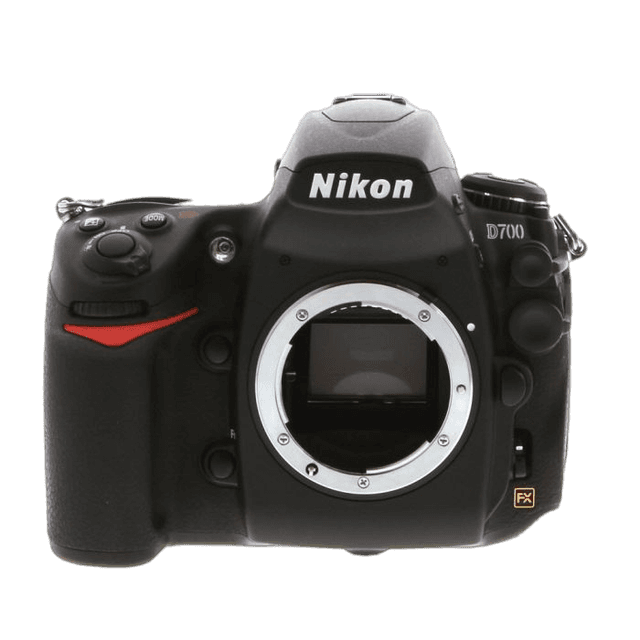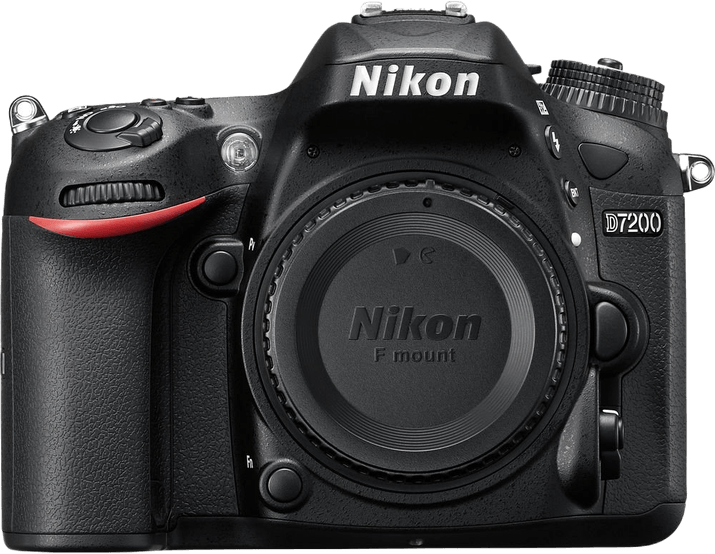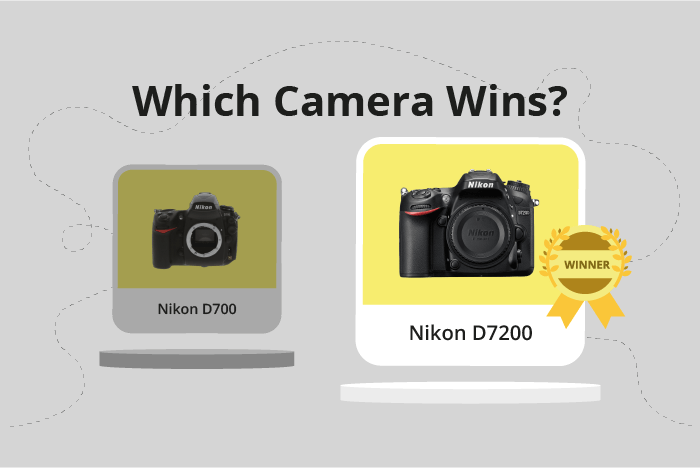Nikon D700 vs D7200 Comparison
Nikon D700

Nikon D7200

The Nikon D7200 emerges as the winner with a score of 68/100, while the Nikon D700 trails behind with a score of 53/100. Both cameras are DSLRs and share a common ground in terms of camera type. However, the D7200 has a more recent release year of 2015, compared to the D700’s release in 2008. This age difference is evident in their launch prices, with the D7200 being more affordable at $1200, while the older D700 had a launch price of $2699.
In terms of size and weight, the D7200 is lighter and more compact, measuring 136 x 107 x 76mm and weighing 765g. On the other hand, the D700 is bulkier, with dimensions of 147 x 123 x 77mm and a weight of 1074g. The compactness and lighter weight of the D7200 make it a more convenient choice for photographers on the go.
Despite its lower score, the D700 still has its merits, particularly for those who appreciate a more robust and sturdy build. However, the Nikon D7200’s higher score, affordability, and compact size make it the superior choice between the two cameras.
Nikon D700 vs D7200 Overview and Optics
The Nikon D7200 emerges as the winner in the optics comparison, scoring 71/100, which is 17 points higher than the Nikon D700’s score of 54/100. Both cameras have certain similarities in their specifications, such as the CMOS sensor type, absence of image stabilization, and the use of Nikon’s F lens mount system. However, there are significant differences in their performance that contribute to the D7200’s superior optics score.
One of the key advantages of the Nikon D7200 is its higher resolution, with 24.2 megapixels compared to the D700’s 12.1 megapixels. This allows the D7200 to capture more detailed images. The D7200 also has a more advanced processor, the Expeed 4, which enhances image quality and processing speed. Furthermore, the D7200’s sensor has a DXOMARK score of 87, which is 7 points higher than the D700’s score of 80, indicating better overall sensor performance.
On the other hand, the Nikon D700 has a faster shooting speed of 8 frames per second, compared to the D7200’s 6 frames per second. This could be beneficial for capturing fast-moving subjects or action photography. Additionally, the D700 has a full-frame sensor, which can provide better low-light performance and a wider field of view compared to the D7200’s APS-C sensor.
Taking these factors into consideration, the Nikon D7200 is the better option for photographers seeking higher image resolution and improved sensor performance. However, the Nikon D700 may still be preferable for those who prioritize shooting speed and a full-frame sensor.
Nikon D700 vs D7200 Video Performance
When comparing the Nikon D700 and the Nikon D7200, it is important to note that the Nikon D700 does not have any video functionality. This means that if video recording is a crucial feature for you, the Nikon D700 is not the right choice.
On the other hand, the Nikon D7200 has a video score of 70 out of 100. This camera offers Full HD video recording with a maximum resolution of 1920 x 1080 pixels. The Nikon D7200 also supports a maximum video frame rate of 60 frames per second, allowing for smooth video capture. Additionally, the D7200 includes built-in time-lapse functionality, providing users with a creative way to showcase the passage of time in their videos.
Taking into account the video capabilities of both cameras, the Nikon D7200 is the clear winner in this aspect. The Nikon D700’s lack of video functionality limits its versatility, while the Nikon D7200 provides users with a range of video recording options, including Full HD resolution and time-lapse features.
Nikon D700 vs D7200 Features and Benefits
The Nikon D7200 takes the lead with a feature score of 59/100, while the Nikon D700 trails behind at 54/100. Both cameras share some common specifications, such as a lack of touchscreen, flip screen, GPS, and Bluetooth. They both come equipped with WiFi capabilities.
The D7200 excels in screen size and resolution, boasting a 3.2-inch screen with a resolution of 1,228,800 dots. This larger and higher resolution screen provides a better viewing experience and more accurate image preview. The D700, on the other hand, features a slightly smaller 3-inch screen with a lower resolution of 922,000 dots.
Despite the D7200’s higher feature score, the D700 still holds its own in some aspects. Both cameras lack a touchscreen, flip screen, GPS, and Bluetooth, which may not be significant drawbacks for some photographers. The D700’s inclusion of WiFi is a useful feature for sharing images and remote camera control.
When comparing the two cameras, the Nikon D7200 stands out as the better option due to its superior screen size and resolution. This advantage allows for improved image previewing and a more enjoyable viewing experience. The Nikon D700, while trailing in feature score, still offers a solid set of features, including WiFi capabilities. However, the D7200’s higher score and enhanced screen specifications make it the more suitable choice for photographers seeking a camera with better features.
Nikon D700 vs D7200 Storage and Battery
The Nikon D7200 outperforms the Nikon D700 in storage and battery with a score of 79/100 compared to the D700’s 43/100. Both cameras do not have USB charging capabilities.
The D7200 has the advantage of two memory card slots, accepting SD, SDHC, and SDXC cards, while the D700 has only one memory card slot for Compact Flash (Type I) cards. This gives the D7200 more flexibility and storage capacity for photographers. Additionally, the D7200 boasts a longer battery life of 1110 shots using the EN-EL15 battery, compared to the D700’s 1000 shots with the EN-EL3e battery.
However, the D700’s use of Compact Flash cards can be seen as an advantage for some users who prefer the durability and faster transfer speeds of these cards.
Based on these points, the Nikon D7200 proves to be the superior choice for storage and battery capabilities, while the Nikon D700 may still appeal to those who prefer Compact Flash cards.
Alternatives to the Nikon D700 and D7200
Are you still undecided about which camera is right for you? Have a look at these popular comparisons that feature the Nikon D700 or the Nikon D7200:

